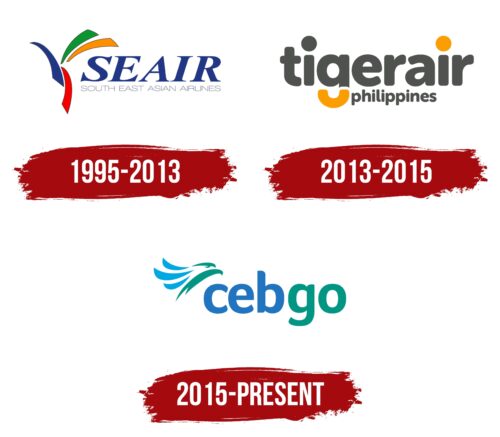The Cebgo logo represents the evolution of a small airline that became a key player in regional aviation. Initially a lesser-known carrier, it gained prominence when Cebu Pacific took it under its wing. This relationship transformed the company, expanding its reach across the Philippines and other parts of Asia. The emblem symbolizes this development, promising passengers new destinations with comfort and style. It reflects the company’s role as a connector that brings regions closer, making travel more accessible and enjoyable.
Cebgo: Brand overview
Founded in 1995 as South East Asian Airlines (SEAir), Cebgo was formerly known as Tigerair Philippines and SEAir. At first, the company used tiny aircraft like the Dornier 328 and LET-410 to do charter flights between the Philippine islands. Because of their capacity to fly on short runways and in airports with little infrastructure, these aircraft were selected to facilitate air travel between the isolated islands of the Philippine archipelago.
The acquisition of a 40% share in SEAir by Singapore’s low-cost airline Tigerair in 2012 marked a key milestone in the company’s history. Due to this cooperation, the Philippine airline changed its name to Tigerair Philippines. This modification signaled the start of a new stage in the company’s growth, linked to the route network expansion and the adoption of the low-cost carrier business model.
The 2014 acquisition of Tigerair by Cebu Pacific, the top low-cost airline in the Philippines, marked another significant turning point in the airline’s history. Through this transaction, Tigerair Philippines joined Cebu Pacific as a subsidiary and benefited from the parent company’s vast route network and resources. Tigerair Philippines continued with its business under its trademark even after its ownership changed.
The airline underwent a rebranding in 2015 and became Cebgo. This modification was made to emphasize the company’s deeper connection with Cebu Pacific and to bolster its standing in the Philippines’ regional aviation sector.
Meaning and History
What is Cebgo?
It is a budget airline based in the Philippines and a subsidiary of Cebu Pacific. It operates domestic flights within the Philippines, connecting smaller cities and regional destinations to Cebu Pacific’s wider network. Known for its budget fares, the company provides affordable air transportation options using a fleet of ATR turboprop airplanes well-suited for short-haul flights and small airports.
1995 – 2013
Cebgo, previously known as SEAIR, Inc., began its operations in 1995 and continued under this brand until 2013. The company logo features the abbreviation SEAIR, under which, in a light, barely noticeable font, is the full name: South East Asian Airlines. This design choice keeps the emblem concise and stylish without overloading it with a lengthy inscription, harmonizing the overall design.
To the left of the name is a bright, colorful element that resembles the feathers of the mythical Philippine bird, Ibong Adarna, known from Filipino folktales. This element symbolizes wings that appear to be spread for flight, adding dynamism and visual appeal to the logo. In Philippine legends, the Ibong Adarna bird has healing powers, symbolically reflecting the airline’s commitment to providing care and comfort to its passengers.
The rainbow-like multicolor of this element creates an atmosphere of festivity, relaxation, and unique emotions that passengers can expect during flights with the company. This decoration emphasizes the focus on vivid and memorable journeys, reinforcing the company’s image as offering not merely flights but unforgettable experiences.
2013 – 2015
After acquiring part of SEAIR, Inc., the former SEAIR began operating under a new brand: Tigerair Philippines. The company logo features a gray inscription with the name, executed in a simple and business-like style. The choice of font and color emphasizes the professionalism and straightforwardness of the brand.
The logo’s design draws special attention, with an orange dot over the letter “i” and part of the letter “g” transformed into a smile. These elements make the logo friendly and welcoming, making it more accessible and appealing. The use of orange is deliberate, hinting at tiger stripes and symbolizing the company’s dynamism and energy.
The logo’s font creates associations with the soft tread of an animal, suggesting grace and lightness. This is enhanced by the image of an orange tail waving in the wind. This element is intended to remind the company of its ability to adapt quickly and flexibly in the changing world of aviation.
The Tigerair Philippines’ emblem stands out for its minimalism and memorable design. It reflects the brand’s core principles—affordability, friendliness, and reliability—while maintaining unique and vivid accents that make the company’s visual identity recognizable and attractive to passengers.
2015 – today
The Cebgo logo features a distinguished eagle, symbolizing the legacy of its parent company. The eagle’s head, depicted with five strokes, exudes confidence and pride. Two green lines form the top of the head, beak, and neck, while three blue lines create the feathers. Next to the eagle is the airline’s name in bold, lowercase letters, designed to look aerodynamic with smooth, rounded sides.
The logo’s minimalist design gives it a modern and sleek appearance, enhancing the aerodynamic feel of the bold letters. The green and blue color scheme highlights the eagle and suggests movement and freedom, key qualities in aviation.
The eagle’s simple lines add sophistication, aligning with contemporary design principles. Green symbolizes growth and renewal, while blue represents trust and reliability. These colors create a dynamic and trustworthy image that resonates with airline values.
The lowercase letters of the airline’s name convey approachability, while their bold, chiseled nature ensures the name stands out. The smooth curves and rounded sides of the font mirror the sleek lines of modern aircraft, reinforcing the aviation theme.







